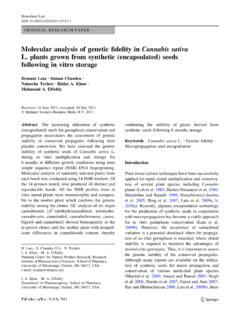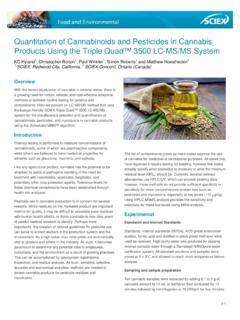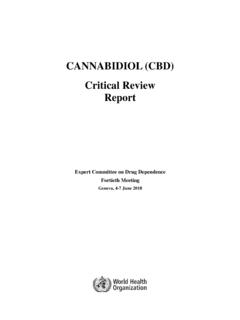Transcription of Chemistry and Analysis of Phytocannabinoids and Other ...
1 Chemistry of Cannabis Constituents17 From:Forensic Science and Medicine: Marijuana and the CannabinoidsEdited by: M. A. ElSohly Humana Press Inc., Totowa, New Jersey17 Chapter 2 Chemistry and Analysisof Phytocannabinoidsand Other Cannabis ConstituentsRudolf Brenneisen1. THE Chemistry OF Phytocannabinoids AND IntroductionTheCannabis plant and its products consist of an enormous variety of chemi-cals. Some of the 483 compounds identified are unique to Cannabis, for example, themore than 60 cannabinoids, whereas the terpenes, with about 140 members formingthe most abundant class, are widespread in the plant kingdom. The term cannab-inoids represents a group of C21 terpenophenolic compounds found until now uniquelyinCannabis sativa L. (1). As a consequence of the development of synthetic cannab-inoids ( , nabilone [2], HU-211 [dexanabinol; ref. {3}, or ajulemic acid [CT-3; ]) and the discovery of the chemically different endogenous cannabinoid receptorligands ( endocannabinoids, , anandamide, 2-arachidonoylglycerol) (5,6), the term Phytocannabinoids was proposed for these particular Cannabisconstituents(7).]
2 Chemistry and ClassificationSo far, 66 cannabinoids have been identified. They are divided into 10 subclasses(8 10) (seeTable 1).18 Brenneisen1. Cannabigerol (CBG) type: CBG was the first cannabinoid identified (11), and its pre-cursor cannabigerolic acid (CBGA) was shown to be the first biogenic cannabinoidformed in the plant (12). Propyl side-chain analogs and a monomethyl ether deriva-tive are Other cannabinoids of this Cannabichromene (CBC) type: Five CBC-type cannabinoids, mainly present as C5-analogs, have been Cannabidiol (CBD) type: CBD was isolated in 1940 (13), but its correct structure wasfirst elucidated in 1963 by Mechoulam and Shvo (14). Seven CBD-type cannabinoidswith C1 to C5 side chains have been described. CBD and its corresponding acid CBDAT able 1 Cannabinoids(continued) Chemistry of Cannabis Constituents19are the most abundant cannabinoids in fiber-type Cannabis (industrial hemp).
3 Iso-lated in 1955, CBDA was the first discovered cannabinoid '9-Tetrahydrocannabinol (THC) type: Nine THC-type cannabinoids with C1 to C5side chains are known. The major biogenic precursor is the THC acid A, whereasTable 1 (continued)(continued)20 BrenneisenTHC acid B is present to a much lesser extent. THC is the main psychotropic prin-ciple; the acids are not psychoactive. THC (6a,10a-trans-6a,7,8,10a-tetrahydro-6,6, 9-trimethyl-3-pentyl-6H-dibenzo[b,d]pyra n-1-ol) was first isolated in 1942 (15), but thecorrect structure assignment by Gaoni and Mechoulam took place in 1964 (16).Table 1 (continued)(continued) Chemistry of Cannabis Constituents215.'8-THC type: '8-THC and its acid precursor are considered as THC and THC acidartifacts, respectively. The 8,9 double-bond position is thermodynamically more stablethan the 9,10 position. '8-THC is approx 20% less active than 1 (continued)(continued)22 Brenneisen6.
4 Cannabicyclol (CBL) type: Three cannabinoids characterized by a five-atom ring andC1-bridge instead of the typical ring A are known: CBL, its acid precursor, and the C3side-chain analog. CBL is known to be a heat-generated artifact from Cannabielsoin (CBE) type: Among the five CBE-type cannabinoids, which are arti-facts formed from CBD, are CBE and its acid precursors A and 1 (continued)(continued) Chemistry of Cannabis Constituents238. Cannabinol (CBN) and Cannabinodiol (CBND) types: Six CBN- and two CBND-typecannabinoids are known. With ring A aromatized, they are oxidation artifacts of THCand CBD, respectively. Their concentration in Cannabisproducts depends on age andstorage conditions. CBN was first named in 1896 by Wood et al. (17) and its structureelucidated in 1940 (18).Table 1 (continued)(continued)24 Brenneisen9. Cannabitriol (CBT) type: Nine CBT-type cannabinoids have been identified, whichare characterized by additional OH substitution.
5 CBT itself exists in the form of bothisomers and the racemate, whereas two isomers (9-a- and 9-b-hydroxy) of CBTV were identified. CBDA tetrahydrocannabitriol ester (ester at 9-hydroxy group) is theonly reported ester of any naturally occurring Miscellaneous types: Eleven cannabinoids of various unusual structure, , with a furanoring (dehydrocannabifuran, cannabifuran), carbonyl function (cannabichromanon, 10-oxo-G-6a-tetrahydrocannabinol), or tetrahydroxy substitution (cannabiripsol), are 1 (continued)(continued) Chemistry of Cannabis THC Potency TrendsFrom 1980 to 1997, a total of 35,213 samples of confiscated Cannabis products(Cannabis, hashish, hashish oil) representing more than 7717 tons seized in the UnitedStates were analyzed by gas chromatography (GC) (19). The mean THC concentra-tion increased from less than in 1980 to in 1997. The maximum levelsfound were and in marijuana and sinsemilla Cannabis, respectively.
6 HashishTable 1 (continued)(continued)26 Brenneisenand hashish oil showed no particular potency trend. The highest THC concentrationsmeasured were and , respectively. Two studies performed in Switzerlandfrom 1981 to 1985 (20) and 2002 to 2003 (21) found mean THC concentrations inmarijuana samples of and , respectively. Maximum levels were and ,respectively. Reasons for this enormous increase in potency include progress in breed-Table 1 (continued)(continued) Chemistry of Cannabis Constituents27ing, the tendency to cultivate under indoor conditions, and the worldwide access toand exchange of seeds originating from high-THC cultivars via the Internet (22). THC in Hemp Seed ProductsThe presence of THC in hemp seed products is predominantly the result of exter-nal contact of the seed hull with cannabinoid-containing resins in bracts and leavesduring maturation, harvesting, and processing (23 25).
7 The seed kernel is not entirelyfree of THC but contains, depending on the hemp variety, less than Pg/g. Studieson hemp oil conducted in the United States, Germany, and Switzerland have shownTHC levels from 11 to 117, 4 to 214, and up to 3568 Pg/g, respectively (24,26 28).These high levels were attributed to seeds from THC-rich, drug-type varieties, andthe lack of adequate cleaning procedures. In recent years, more careful seed dryingand cleaning have considerably lowered the THC content of seeds and oil available inthe United States (23,24). However, oils and hulled seeds containing 10 20 and 2 3 Pg/gTHC, respectively, are still found on the US 1 (continued) Noncannabinoid-Type TerpenoidsThe typical scent of Cannabis results from about 140 different terpenoids. Iso-prene units (C5H8) form monoterpenoids (C10 skeleton), sesquiterpenoids (C15),diterpenoids (C20), and triterpenoids (C30;seeTable 2).
8 Terpenoids may be acyclic,monocyclic, or polycyclic hydrocarbons with substitution patterns including alcohols,ethers, aldehydes, ketones, and esters. The essential oil (volatile oil) can easily beobtained by steam distillation or vaporization. The yield depends on the Cannabistype (drug, fiber) and pollination; sex, age, and part of the plant; cultivation (indoor,outdoor etc.); harvest time and conditions; drying; and storage (29 31). For example,fresh buds from an Afghani variety yielded essential oil (32). Drying and stor-age reduced the content from after 1 week and 3 months to and ,respectively(32). Monoterpenes showed a significantly greater loss than sesquiterpe-nes, but none of the major components completely disappeared in the drying L of essential oil per ton resulted from freshly harvested outdoor-grownCannabis, corresponding to about 10 L/ha (29).
9 The yield of nonpollinated( sinsemilla )Cannabis at 18 L/ha was more than twofold compared with pollinatedCannabis (8 L/ha) (30). Sixty-eight components were detected by GC and GC/massspectrometry (MS) in fresh bud oil distilled from high-potency, indoor-grown Can-nabis (32). The 57 identified constituents were 92% monoterpenes, 7% sesquiterpe-nes, and approx 1% Other compounds (ketones, esters; refs. 9and32). The dominatingmonoterpenes were myrcene (67%) and limonene (16%). In the essential oil fromoutdoor-grownCannabis, the monoterpene concentration varied between of the total terpenoid content (29). The sesquiterpenes ranged from to most abundant monoterpene was E-myrcene, followed by trans-caryophyllene,D-pinene,trans-ocime ne, and D-terpinolene. Drug-type Cannabis generally con-tained less caryophyllene oxide than fiber-type Cannabis. Even in drug-type Can-nabis, the THC content of the essential oil was not more than (29).
10 In theessential oil of five different European Cannabis cultivars, the dominating terpeneswere myrcene ( ), D-pinene ( ), D-terpinolene ( ), trans-caryophyllene ( ), and D-humulene ( ; ). The main differ-ences between the cultivars were found in the contents of D-terpinolene and terpenoids present only in traces are sabinene, D-terpinene, 1,8-cineole(eucalyptol), pulegone, J-terpinene, terpineol-4-ol, bornyl acetate, D-copaene,alloaromadendrene, viridiflorene, E-bisabolene,J-cadinene,trans-E-farnesen e,trans-nerolidol, and E-bisabolol(29,32,34). HydrocarbonsThe 50 known hydrocarbons detected in Cannabisconsist of n-alkanes rang-ing from C9 to C39, 2-methyl-, 3-methyl-, and some dimethyl alkanes (10,35). Themajor alkane present in an essential oil obtained by extraction and steam distilla-tion was the n-C29 alkane nonacosane ( and , respectively). Other abun-dant alkanes were heptacosane, 2,6-dimethyltetradecane, pentacosane, hexacosane,and of Cannabis Nitrogen-Containing CompoundsCannabis sativa L.








